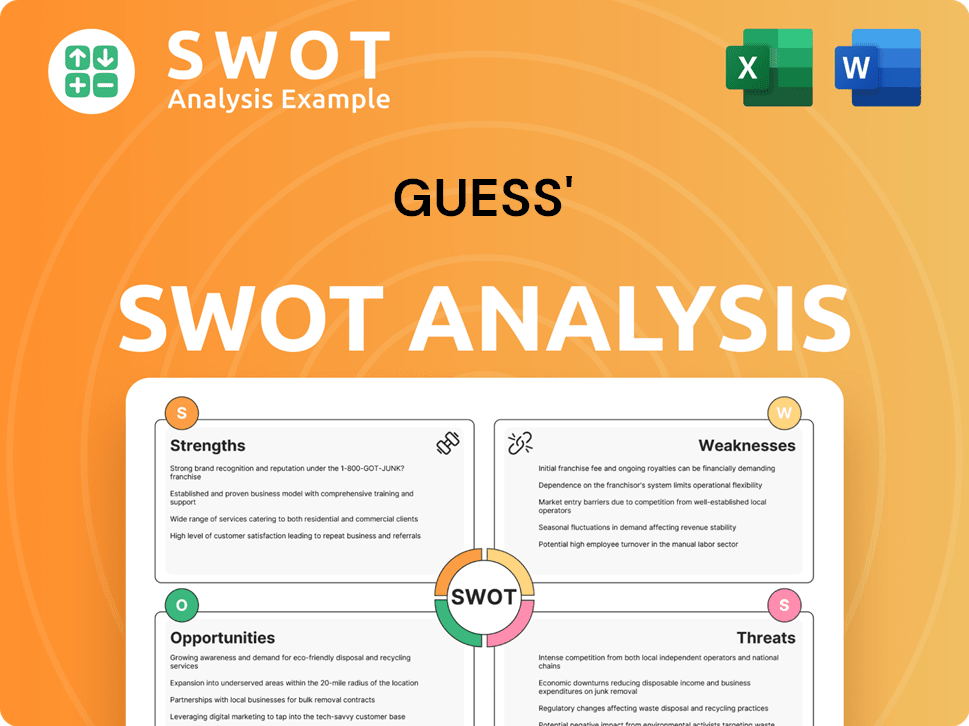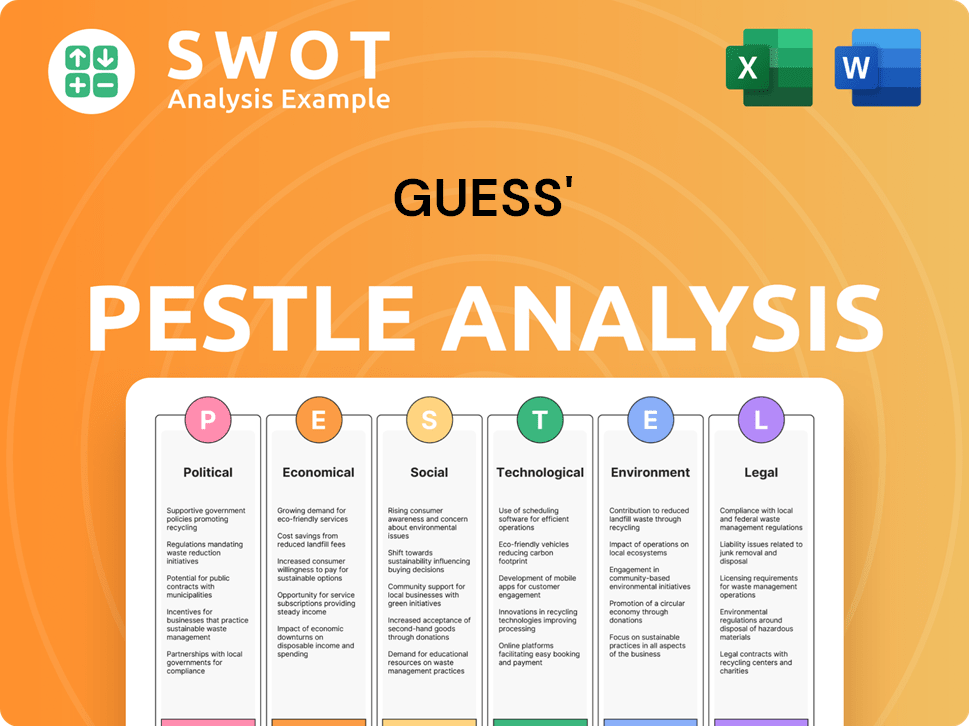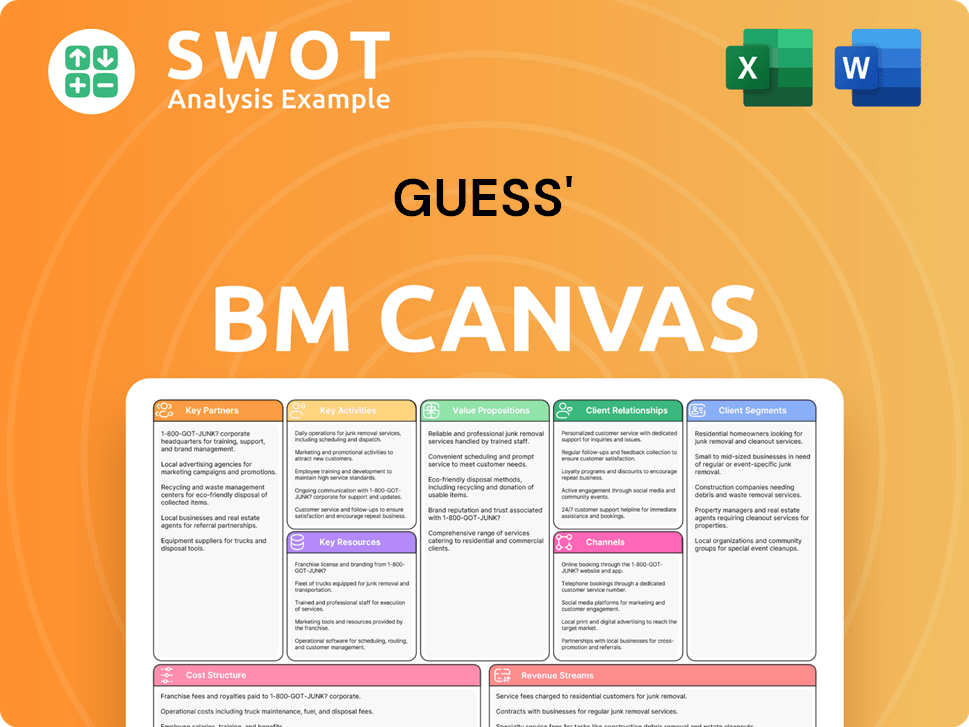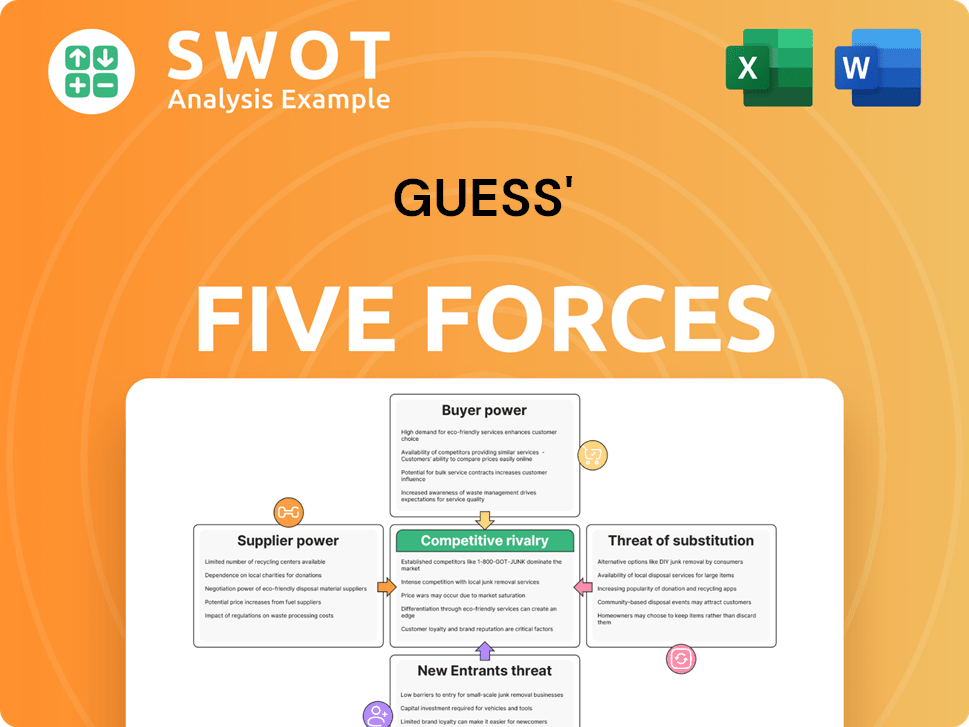Guess' Bundle
Can Guess? Stay Ahead in the Fashion Race?
The fashion industry is a whirlwind of trends and competition, making it crucial to understand the players' strategic positioning. Guess?, a global lifestyle brand, finds itself in this dynamic environment, battling rapidly changing consumer preferences and digital transformations. From its denim-focused beginnings in 1981, Guess? has evolved into a diversified fashion powerhouse, but its journey is far from over.

To truly grasp Guess's position, we must conduct a thorough Guess' SWOT Analysis and explore its competitive landscape. This analysis will delve into the intricate details of Guess' market analysis, evaluating its key competitors and strategies. By examining the apparel market share and the broader fashion industry competition, we'll uncover how Guess? aims to maintain its relevance and capture market share in this fiercely contested arena, offering insights into its brand strategy and competitive advantages.
Where Does Guess'’ Stand in the Current Market?
Guess?, Inc. carves out a significant niche in the global apparel and accessories market, operating through retail, wholesale, and licensing channels. The company focuses on the premium casual and contemporary fashion segments. Its diverse product lines, including clothing, handbags, watches, and footwear, cater to a broad customer base that values trendy, accessible luxury.
The company's financial performance reflects its capacity to compete with larger fashion conglomerates. As of its fiscal year ending February 3, 2024, Guess? reported net revenue of approximately $2.78 billion, demonstrating its substantial scale within the industry. Guess? has a strong presence across the Americas, Europe, and Asia, with Europe often contributing a substantial portion of its overall revenue.
Guess? strategically emphasizes its brand heritage while embracing digital transformation to reach a younger, digitally native consumer base. It has invested in its e-commerce capabilities to complement its brick-and-mortar presence, adapting to changing consumer shopping habits. This approach helps maintain a competitive edge in the dynamic fashion industry. A detailed Guess market analysis reveals its strategic positioning.
Guess? primarily operates through three key segments: retail, wholesale, and licensing. These segments allow the company to reach a wide customer base. The retail segment includes company-owned stores, while wholesale involves selling products to third-party retailers. Licensing generates revenue through brand extensions.
The value proposition of Guess? centers on offering trendy, accessible luxury apparel and accessories. It focuses on providing fashionable products that resonate with a broad consumer demographic. The brand's strong recognition and global distribution network contribute to its sustained competitive advantage.
Guess? has a significant presence in the Americas, Europe, and Asia. Europe is often a major contributor to its overall revenue. In fiscal year 2024, Europe's net revenue was $1.43 billion. This diversified geographic footprint helps mitigate risks and capitalize on global fashion trends.
The company is actively investing in its e-commerce capabilities. This is to adapt to changing consumer shopping habits. This digital focus complements its brick-and-mortar presence. It helps Guess? reach a younger, digitally native consumer base.
Guess? maintains a competitive edge through brand recognition and an extensive global distribution network. Its consistent revenue streams demonstrate resilience in a highly competitive environment. The company's Guess competitive landscape includes various rivals in the fashion industry.
- Guess? focuses on premium casual and contemporary fashion.
- The brand targets a broad customer base valuing trendy, accessible luxury.
- Geographic diversification across the Americas, Europe, and Asia supports its market position.
- Digital transformation and e-commerce investments are key strategic initiatives.
Guess' SWOT Analysis
- Complete SWOT Breakdown
- Fully Customizable
- Editable in Excel & Word
- Professional Formatting
- Investor-Ready Format

Who Are the Main Competitors Challenging Guess'?
The competitive landscape for Guess?, Inc. is multifaceted, encompassing both direct and indirect rivals across various product categories and geographical markets. A thorough Guess market analysis reveals a dynamic environment shaped by established fashion brands, fast-fashion retailers, luxury labels, and emerging direct-to-consumer (DTC) companies. Understanding these competitors is crucial for evaluating Guess' market position analysis and developing effective Guess brand strategy.
Direct competitors in the apparel and accessories sectors include global fashion brands that offer lifestyle collections similar to Guess?. Indirect competition arises from fast-fashion retailers and luxury brands, which influence consumer preferences and pricing strategies. Furthermore, the competitive environment is constantly reshaped by mergers, acquisitions, and technological advancements, requiring Guess? to adapt and innovate continuously. For more insights, you can explore the Target Market of Guess'.
Guess' key rivals in the fashion industry are diverse and exert pressure through brand recognition, distribution networks, and product innovation. These competitive forces necessitate strategic responses from Guess? to maintain and grow its market share. The fashion industry competition is intense, making it essential for Guess? to differentiate its offerings and adapt to evolving consumer demands.
Direct competitors include established global fashion brands. These brands offer a lifestyle collection of clothing, handbags, watches, and footwear, similar to Guess?. They challenge Guess? through strong brand recognition and extensive distribution networks.
PVH Corp., with brands like Calvin Klein and Tommy Hilfiger, is a significant direct competitor. These brands compete with Guess? in apparel and accessories. They are known for their strong brand presence and global reach.
Ralph Lauren competes in the apparel market with its classic American style. This brand challenges Guess? through its brand recognition and established customer base. Ralph Lauren's market position directly impacts Guess?.
Capri Holdings, which includes Michael Kors, Versace, and Jimmy Choo, is a key competitor, especially in accessories. Michael Kors, with its focus on accessible luxury, directly competes with Guess?'s handbag and watch lines. These brands challenge Guess? through their product offerings and brand prestige.
Indirect competitors include fast-fashion retailers and luxury brands. Fast-fashion retailers offer trend-driven apparel at lower price points. Luxury brands influence consumer aspirations and can draw away customers.
Zara and H&M are fast-fashion retailers that compete with Guess? by offering trend-driven apparel at lower prices. This competition puts pressure on Guess?'s pricing strategies, especially for casual clothing lines. These retailers have a significant impact on the apparel market share.
The competitive landscape is further shaped by emerging direct-to-consumer (DTC) brands. These brands often use online sales and social media to offer niche products and personalized experiences, disrupting traditional retail models. Guess' strategies to beat competitors include aggressive marketing campaigns and technological advancements in e-commerce. The competitive advantages of Guess brand are constantly tested by these dynamic market forces. In 2024, the global apparel market was valued at approximately $1.7 trillion, with significant competition from both established brands and emerging players. Guess' financial performance compared to competitors is influenced by these dynamics, requiring continuous adaptation and innovation to maintain its market position.
Several factors contribute to the competitive dynamics in the fashion industry, influencing Guess' competitive landscape. These factors include brand recognition, distribution networks, product innovation, pricing strategies, and marketing efforts. The latest trends in Guess' competitive environment are constantly evolving, necessitating strategic adjustments.
- Brand Recognition: Established brands with strong recognition have a significant advantage.
- Distribution Networks: Extensive global distribution networks enable broader market reach.
- Product Innovation: Consistent innovation is crucial for staying ahead of trends.
- Pricing Strategies: Competitive pricing is essential to attract and retain customers.
- Marketing and Advertising: Effective marketing campaigns build brand awareness.
Guess' PESTLE Analysis
- Covers All 6 PESTLE Categories
- No Research Needed – Save Hours of Work
- Built by Experts, Trusted by Consultants
- Instant Download, Ready to Use
- 100% Editable, Fully Customizable

What Gives Guess' a Competitive Edge Over Its Rivals?
The competitive landscape for Guess?, Inc. is shaped by its established brand recognition and strategic business model. Founded in 1981, the company has built a strong global presence, particularly in the apparel market. This longevity has allowed Guess? to cultivate a loyal customer base and a distinct brand identity. Understanding the Brief History of Guess' is crucial to grasping its current market position and competitive advantages.
Guess?'s competitive edge stems from several key factors. Its vertically integrated structure, encompassing design, marketing, distribution, and licensing, provides greater control over its operations. This integration allows for quicker responses to fashion trends and consumer demands. Furthermore, its extensive global distribution network, including retail stores, wholesale partnerships, and e-commerce platforms, ensures broad market reach. These elements collectively form the basis of Guess?'s competitive strategy in the fashion industry.
The company's ability to adapt and innovate is essential for maintaining its competitive advantage. The fashion industry is dynamic, with rapidly changing trends and intense competition. Guess? must continuously evolve its product offerings and marketing strategies to stay relevant. Its licensing segment also plays a vital role, extending the brand into various product categories and increasing brand visibility.
Guess? benefits significantly from its strong brand recognition. The brand's association with youthful and adventurous styling has resonated with a broad consumer base. This brand loyalty is a key asset, driving repeat purchases and attracting new customers. The company's marketing efforts consistently reinforce this brand image, maintaining its appeal in a competitive market.
Guess?'s vertically integrated business model provides a significant competitive advantage. This structure allows for greater control over the supply chain, product quality, and speed to market. By managing design, marketing, distribution, and licensing internally, Guess? can respond more efficiently to fashion trends and consumer preferences. This integrated approach enhances operational efficiency and responsiveness.
Guess? boasts an extensive global distribution network, which includes its own retail stores, wholesale partnerships, and a growing e-commerce platform. This multi-channel approach ensures that Guess? products are accessible to a wide range of consumers across different geographies and shopping preferences. The diversified distribution strategy supports the company's market reach and sales performance.
The licensing segment is a valuable component of Guess?'s business strategy. By extending its brand into various product categories like watches, eyewear, and fragrances through partnerships, Guess? generates royalty income and increases brand visibility. This strategy allows the company to expand its market presence without incurring significant operational overhead.
The competitive advantages of Guess? are multifaceted, encompassing brand strength, operational efficiency, and strategic market positioning. These elements collectively support the company's ability to compete effectively in the fashion industry. The brand's ability to adapt to evolving fashion cycles and maintain a relevant product assortment, combined with its established infrastructure, provides a sustainable competitive edge.
- Brand Recognition: Guess? has a strong brand reputation, recognized globally for its youthful and adventurous aesthetic.
- Vertical Integration: The company's integrated business model allows for greater control over its operations, from design to distribution.
- Global Distribution: A comprehensive distribution network ensures products are accessible to a wide consumer base.
- Licensing: The licensing segment expands the brand's reach and generates additional revenue streams.
Guess' Business Model Canvas
- Complete 9-Block Business Model Canvas
- Effortlessly Communicate Your Business Strategy
- Investor-Ready BMC Format
- 100% Editable and Customizable
- Clear and Structured Layout

What Industry Trends Are Reshaping Guess'’s Competitive Landscape?
The fashion industry is undergoing significant shifts, creating both challenges and opportunities for companies like Guess?. The evolving landscape demands adaptability, with a focus on digital transformation, sustainability, and personalized customer experiences. Understanding the Guess competitive landscape and responding to these trends is critical for maintaining and growing market share.
Guess market analysis reveals that the company faces intense competition from both established brands and emerging players. Economic fluctuations, shifts in consumer preferences, and global trade policies further complicate the environment. However, strategic investments in key areas can position Guess? for future success.
The fashion industry is experiencing rapid digitization, with e-commerce and digital engagement becoming increasingly important. Sustainability and ethical practices are also key drivers. Social media and personalized fashion continue to shape the competitive environment.
Intense competition from various players, potential economic downturns impacting consumer spending, and evolving global trade policies pose significant challenges. Adapting to these challenges requires strategic agility and innovation.
Emerging markets, particularly in Asia, offer significant growth potential. Product innovation, such as smart apparel and sustainable materials, can unlock new revenue streams. Strategic partnerships and collaborations can also drive growth.
Investing in digital infrastructure, embracing sustainability, and focusing on product innovation are crucial. Strengthening brand loyalty and differentiating through sustainable collections are also important. Strategic investments are essential.
To thrive, Guess? must focus on several key areas. This includes enhancing its digital presence, improving supply chain sustainability, and leveraging social media for deeper customer engagement. These strategies are critical for long-term success.
- E-commerce Expansion: Expanding online sales channels and enhancing the digital customer experience. In 2024, e-commerce sales accounted for a significant portion of total revenue.
- Sustainability Initiatives: Enhancing supply chain sustainability and promoting eco-friendly materials. This aligns with consumer preferences for ethical practices.
- Product Innovation: Developing innovative products, such as smart apparel, to cater to evolving consumer demands. This can open new revenue streams.
- Strategic Partnerships: Forming partnerships with designers or other brands to drive growth. Collaborations enhance brand appeal.
The Guess competitive landscape is influenced by various factors, including the strategies of Guess competitors. The company's ability to adapt to these changes and capitalize on new opportunities is crucial for its future. For more detailed insights into the company's strategic direction, consider reading about the Growth Strategy of Guess'.
Guess' Porter's Five Forces Analysis
- Covers All 5 Competitive Forces in Detail
- Structured for Consultants, Students, and Founders
- 100% Editable in Microsoft Word & Excel
- Instant Digital Download – Use Immediately
- Compatible with Mac & PC – Fully Unlocked

Related Blogs
- What are Mission Vision & Core Values of Guess' Company?
- What is Growth Strategy and Future Prospects of Guess' Company?
- How Does Guess' Company Work?
- What is Sales and Marketing Strategy of Guess' Company?
- What is Brief History of Guess' Company?
- Who Owns Guess' Company?
- What is Customer Demographics and Target Market of Guess' Company?
Disclaimer
All information, articles, and product details provided on this website are for general informational and educational purposes only. We do not claim any ownership over, nor do we intend to infringe upon, any trademarks, copyrights, logos, brand names, or other intellectual property mentioned or depicted on this site. Such intellectual property remains the property of its respective owners, and any references here are made solely for identification or informational purposes, without implying any affiliation, endorsement, or partnership.
We make no representations or warranties, express or implied, regarding the accuracy, completeness, or suitability of any content or products presented. Nothing on this website should be construed as legal, tax, investment, financial, medical, or other professional advice. In addition, no part of this site—including articles or product references—constitutes a solicitation, recommendation, endorsement, advertisement, or offer to buy or sell any securities, franchises, or other financial instruments, particularly in jurisdictions where such activity would be unlawful.
All content is of a general nature and may not address the specific circumstances of any individual or entity. It is not a substitute for professional advice or services. Any actions you take based on the information provided here are strictly at your own risk. You accept full responsibility for any decisions or outcomes arising from your use of this website and agree to release us from any liability in connection with your use of, or reliance upon, the content or products found herein.